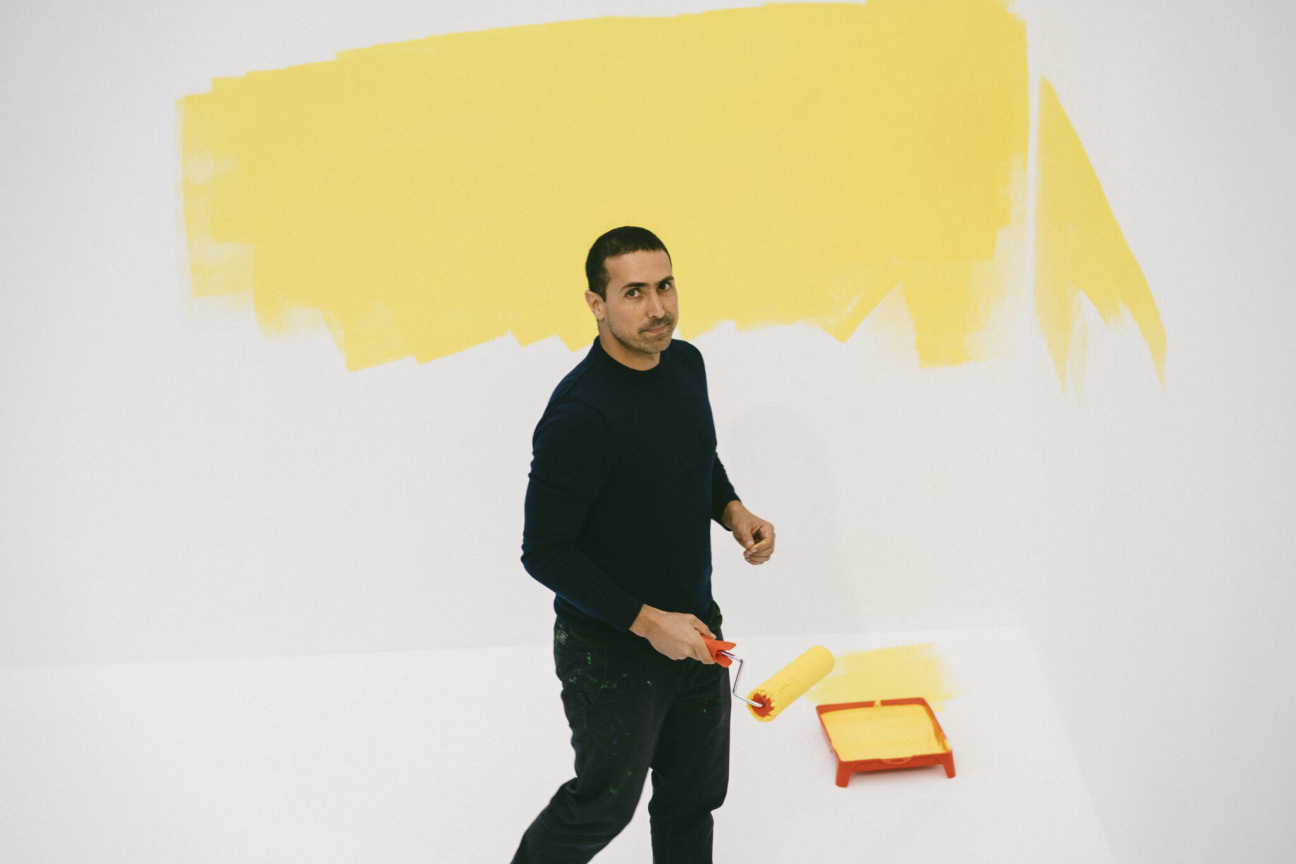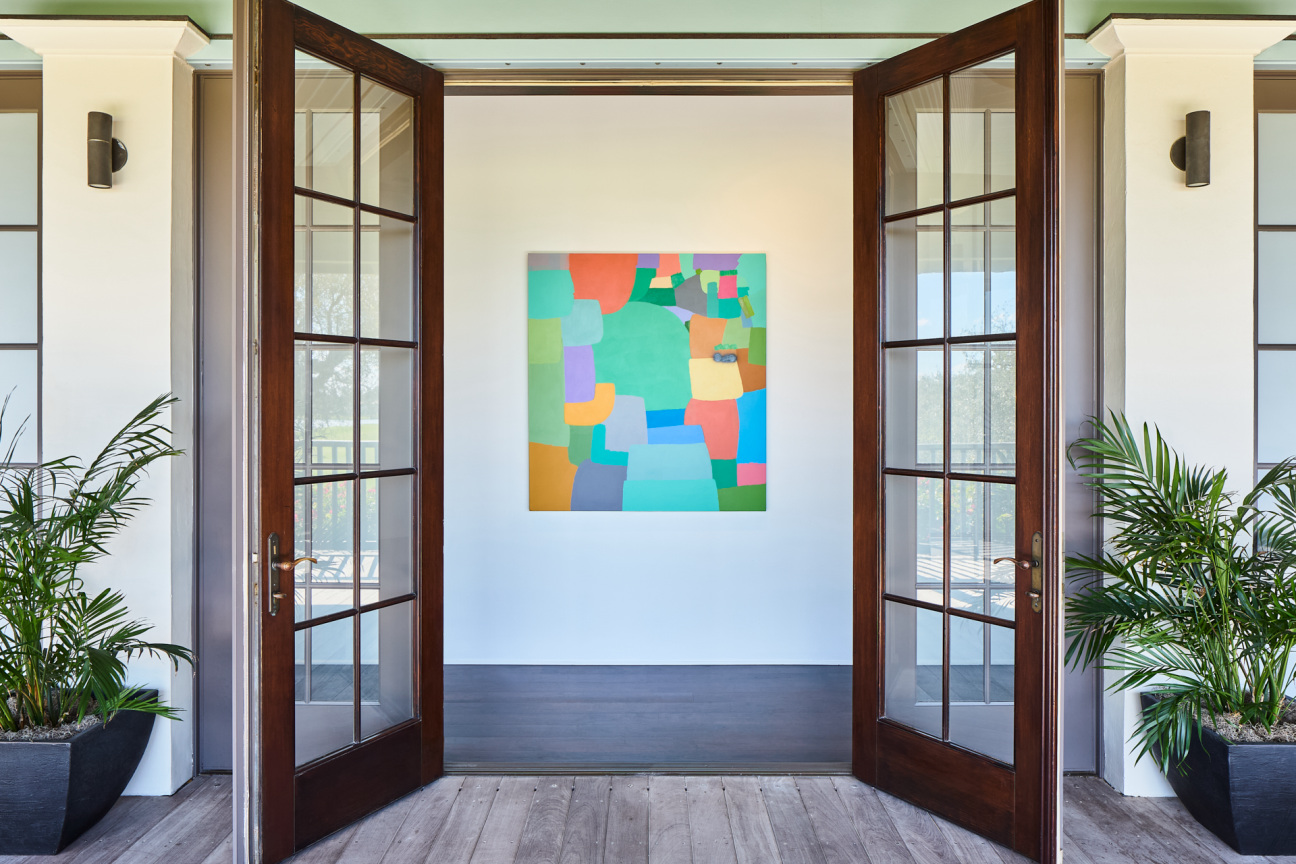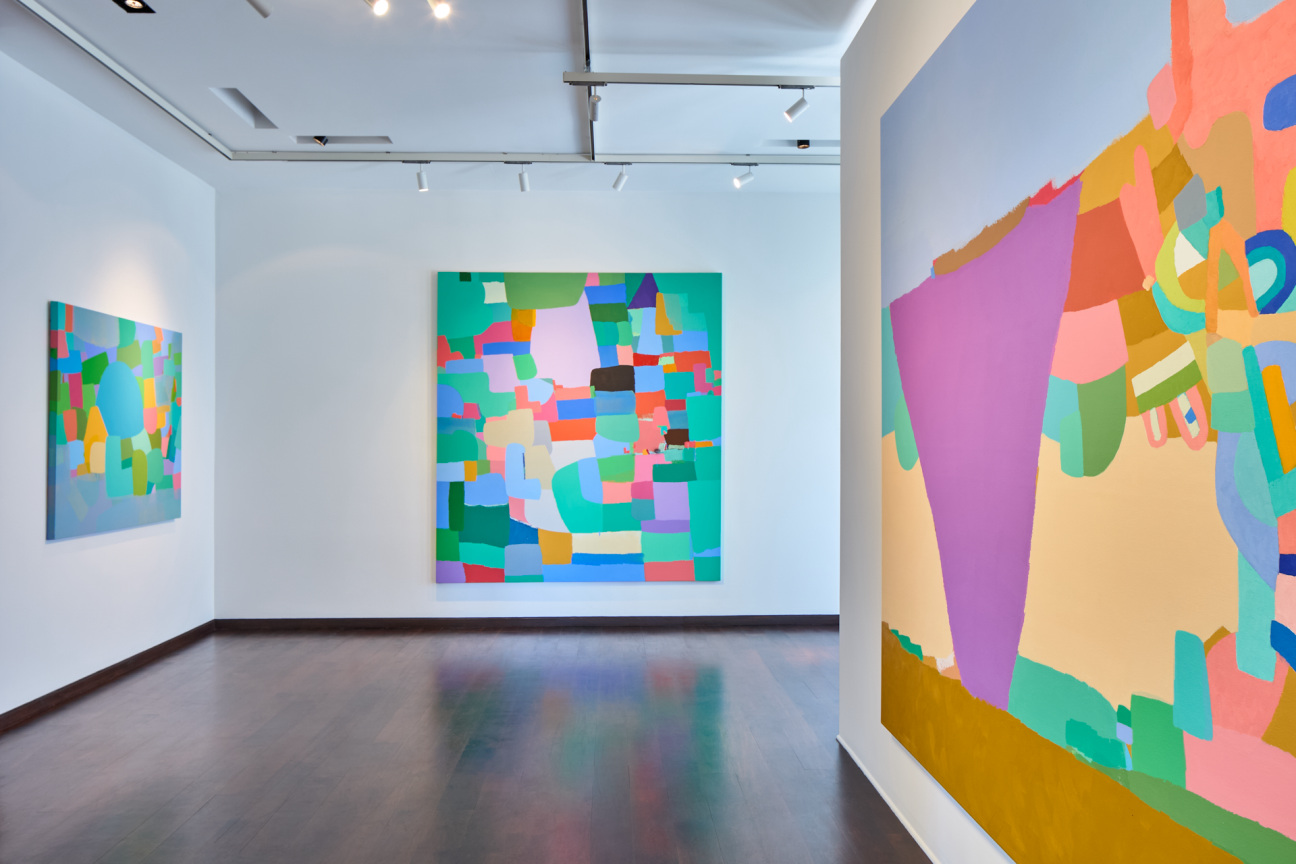
Federico Herrero is a magician of color. In 2000, he installed small, abstract paintings across his native city of San José (some stayed in place for days; others disappeared within hours). Three years later, he created a map of the world at the bottom of a public pool in Havana. Color and form have always been inextricably linked to place for the Costa Rican artist.
His latest exhibition, at The Gallery at Windsor in Florida, draws its title and inspiration from the Costa Rican poet Alfonso Chase, whose work also draws on the country’s landscape, sights, and sounds. “A Piece of Waterfall in the Sound of Crickets,” organized by MoMA PS1’s assistant curator Elena Ketelsen González, presents recent paintings and monotypes that deepen Herrero’s two-decade exploration of mundane beauty.
The Hon. Hilary M. Weston, Windsor co-founder and creative director of The Gallery at Windsor, remarked of the show, “Federico’s work caught my attention for the way he uses abstraction to express his profound relationship with the urban and natural landscapes of Costa Rica. His compositions resonate strongly with the tropical setting of Windsor and the dynamic lifestyle of our community. This show follows our long-standing curatorial focus at The Gallery, which has presented a diverse roster of some of the world’s leading contemporary artists for more than two decades.” Among those artists are Christo and Jeanne-Claude, Ed Ruscha, Peter Doig, and Alex Katz.
With a month left to go see Herrero’s exhibition in Vero Beach, Florida, the creative tells CULTURED about his kinship with Alfonso Chase and the personal experiences that inspired his latest body of work.

CULTURED: How were you introduced to the work of Alfonso Chase, and what about this poem spoke to you?
Federico Herrero: During a conversation with Elena Ketelsen González, the curator of the Windsor exhibition, who also has roots in Costa Rica, we spoke at length about the relationship between center and periphery. She was reminded of the Costa Rican poet Alfonso Chase—who spent time in New York but returned to Costa Rica—and the ways in which his journey mirrored my own experiences. I had the opportunity to study in New York, and I could have chosen to stay and build my career there, but instead, instinctively, I decided to return home.
This was on some level an act of resistance to the idea of having to be at the “center” of the contemporary art world in order to meaningfully contribute to it. I was looking for the right place to work—where I could have some distance and participate in the building of a creative community. I find the path I chose is reflected in Chase’s poems. The way he describes these tensions between smaller countries and creative centers resonates with me.
CULTURED: How did this opportunity to exhibit at Windsor come about, and what kind of conversations did you have with the team about the presentation and unique setting?
Herrero: I was invited by Mrs. Weston to exhibit at The Gallery, and it seemed like a remarkable setting that had a clear relationship to my work while also having this incredible history of hosting exhibitions by artists I admire. The preparation for this exhibition had a very special dimension, which was the publication of a new catalogue dedicated to my work by The Gallery at Windsor and DelMonico Books. The conversations I had with the team at Windsor and with Elena [Ketelsen González] during the creation of this publication shaped very profoundly how we conceptualized the physical exhibition, and vice versa.
It was a deeply collaborative and rewarding process. In addition to Elena's essay, the catalogue for the exhibition features a conversation between me and Bernardo Mosqueira, chief curator [at the] Institute for Studies on Latin American Art in New York. These wide-ranging discussions gave me a lot of perspective on my own process and work.

CULTURED: For those who haven't been to Costa Rica, or aren't from there, what do you hope they take away about the country from your work?
Herrero: Costa Rica exists at a crossroads of cultures and geographies, which has created an enormous amount of diversity in every aspect of life. The built environments of the cities here and the nature that surrounds them often intersect and overlap, so my work deals a lot with this experience, translating these elements and observations into a language of visual poetry.
I often think about the work of Etel Adnan, who has long been an inspiration for me, and how it was rooted firmly in the poetics of place. I’m not trying to sell any singular idea about my country—I’m not a travel agent—but I am an artist who understands my own experiences by transforming visual information, color, and forms into a vocabulary of its own.
CULTURED: How do you think this body of work builds upon past projects?
Herrero: With each project, the space created by the tension between the forms within my paintings, and the way these forms touch each other, becomes increasingly important. I have been spending a lot of time focused on understanding the generative space of this gap and what possibilities are contained within it.

CULTURED: Florida, where you are exhibiting, is thought of as a similarly sunny environment in the States. Do you see any similarities or particular differences from where you grew up? How do you think showing the pieces in that context changes their reception?
Herrero: The reception to my work, even when exhibited within different contexts, is often similar because abstraction and landscape are languages that can be so universal. There will always be an entry point as long as people are open to seeing what's there. While environmentally there are plenty of similarities between Costa Rica and Florida, there are also political differences.
The United States has spent a lot of the last years enmeshed in internal conflict—a degree of polarization that is slowly starting to appear in Costa Rica, as it is in many other countries, but hasn’t yet reached that level of intensity. I worry about that, as it seems a looming threat to our democratic system.
CULTURED: How have you seen your relationship to color and abstraction change over the past 20 years?
Herrero: I started exhibiting my work at a very young age, so naturally, my practice has evolved as I have gotten older. Traveling to various places, meeting other artists, and exposure to other cultures have provided me with inspiration that’s moved my work forward. In my early work, the paintings were characterized by an almost nervous, vibrational intensity, and the forms were very densely layered. In recent years, the paintings seem calmer and more assured, with looser relationships between the forms and more plays of transparency and texture.

CULTURED: Are there any pieces in the show that you're particularly excited to share with viewers?
Herrero: Lost at Sea is a very personal work for me, as it evokes a journey I take regularly to visit a place in the Pacific that holds a lot of meaning. It attempts to capture the shifting topography of a memory. Twin Hearts is another important work to me. Both are rooted in notions of movement, as well as expressions of the psychological—translations of emotion into form.
CULTURED: What, for you, defines the Costa Rican landscape?
Herrero: Volcanos, and the landscape created by their eruption, serve as a constant reminder that everything is ephemeral. These forms often appear within my work and are one of my favorite aspects of the landscape in Central America.
“A Piece of Waterfall in the Sound of Crickets" is on view through April 26, 2024 at The Gallery at Windsor in Vero Beach, Florida.










 in your life?
in your life?

